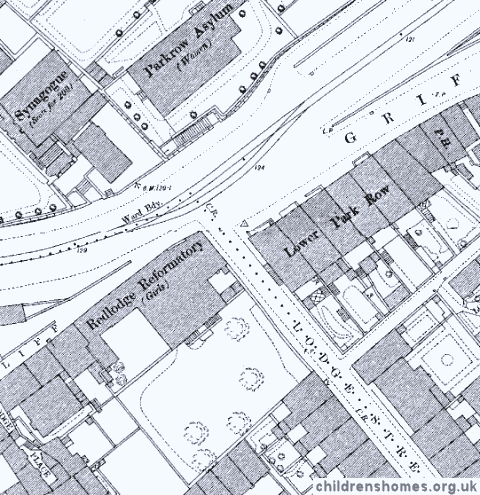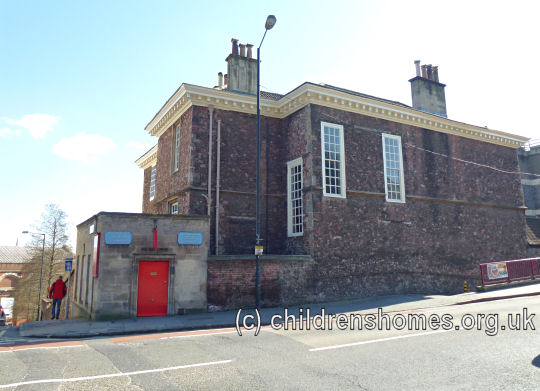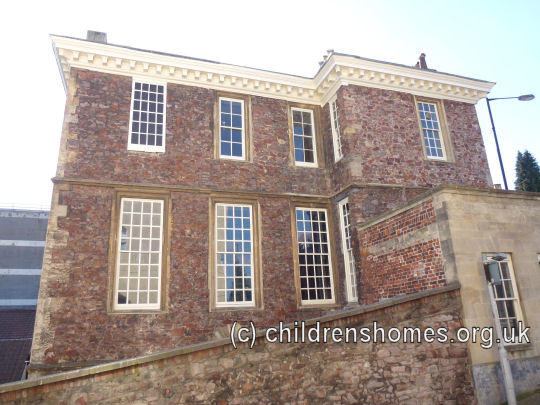Red Lodge Reformatory for Girls, Bristol, Gloucestershire
The Red Lodge Reformatory School for Girls was opened in 1854 at Park Row, Bristol. It was founded by Miss Mary Carpenter, a leading light in the Reformatory School movement and author of the influential 1851 book Reformatory Schools for the Children of the Perishing and Dangerous Classes, and for Juvenile Offenders. Reformatory Schools aimed to offer an alternative to adult prison for for convicted juvenile offenders. Carpenter believed that the treatment in such institutions should be based on the love of the child and, ideally, provide a family-sized environment. She also considered that there should be no forced work, that recreation and sport should be provided, and that corporal punishment kept to a minimum. Carpenter's writings and her evidence to an 1852 parliamentary inquiry on juvenile delinquents helped shape the 1854 Youthful Offenders Act which authorized the establishment of reformatory schools by voluntary bodies, certified by the state and partly funded by the Treasury.
Carpenter had previously help found the Kingswood Reformatory which had opened two years earlier. The new establishment was made possible through the purchase of the Red Lodge, a house dating back to 1568 and previously used as doctors' flats, by Lady Noel Byron, widow of the eminent poet. Carpenter's brother had once been tutor in the family of Lord Lovelace who married Lord Byron's only 'official' daughter, Ada. Lady Byron also shared Carpenter's views on the subject of juvenile reform. Red Lodge, the first reformatory to cater exclusively for girls, was opened on October 10th, 1854, with Mary Carpenter as its resident superintendent. On December 9th, 1854, the establishment was officially certified to accommodate up to 52 girls sentenced by the courts to a period of detention of up to five years. Voluntary cases could also be admitted upon payment of five shillings a week, payable quarterly in advance. The School took only girls below the age of 14, although under 12 was preferred. No girl was kept above the age of 16.
The location of the home is shown on the 1884 map below.

Red Lodge Reformatory for Girls site, Bristol, c.1884.

Red Lodge Reformatory from the north, 2013. © Peter Higginbotham

Red Lodge Reformatory, 2013. © Peter Higginbotham
The School's Principle, Rules and Regulations proclaimed how Miss Carpenter's ideals were to be put into practice:

Red Lodge Reformatory from the east, 2013. © Peter Higginbotham
Miss Carpenter personally superintended the School from her own residence which stood opposite at 1 Lower Park Row. In 1858, the staff of the establishment comprised a matron (Miss Stuart), a schoolmistress and an assistant laundress. Miss Stuart subsequently took charge of the "cottage", a small house adjoining the main School, which was used as a probationary home for girls about to leave Red Lodge. The post of matron was then taken over by Mrs Johnson, with Miss Stuart being succeeded by Mrs Meadows in the cottage. There was a fairly regular turnover of staff, compounded by the absence of Miss Carpenter during her visits to India in the late 1860s. In around 1880, 22-year-old Elizabeth Anne Langabeer was appointed matron with her younger sister, Sarah Jane Langabeer, as schoolmistress. The parents of the two women ran another of Miss Carpenter's institutions, the Park Row Industrial School for Boys, which was located nearby.

Red Lodge Reformatory from the south-east, 2013. © Peter Higginbotham
Girls at Red Lodge received both classroom lessons and industrial training in the form of needlework and laundry work. The girls in the cottage also baked bread for the establishment.

Red Lodge Reformatory from the north-east, 2013. © Peter Higginbotham
In 1918, following a decline in the number of girls being placed there, it was decided to close the School. The closure, the following year, coincided with the retirement of the Langabeer sisters who had by this time had both been in post for almost 40 years.
The Red Lodge was then owned by Dr Estlin Carpenter, a nephew of Mary Carpenter. For a time it seemed that the site might be bought by property speculators and its historic interior gutted. It was saved by a public spirited citizen, James Fuller Eberle, who purchased the property from Dr Carpenter on behalf of a local arts foundation, the 'Bristol Savages', who then passed the bulk of the property into the care of the Bristol Corporation. Since 1948, the house has been a council-run museum.
Records
Note: many repositories impose a closure period of up to 100 years for records identifying individuals. Before travelling a long distance, always check that the records you want to consult will be available.
- Bristol Record Office, 'B' Bond Warehouse (in the 'Create Centre' section from 3-Dec-2013), Smeaton Road, Bristol BS1 6XN. Holdings include: Matron's reports on future history and conduct of girls who attended the Reformatory (1887-1921); Journal (1855-1860); Principles, rules and regulations of the school (1854); Account Books (1854-1920); Minute Books (1878-1918); Fiftieth Anniversary Programme (9 December 1904).
Census
Bibliography
- Principles, Rules, and Regulations of The Red Lodge Girls' Reformatory School, Bristol
- Carpenter, Mary Reformatory Schools, for the Children of the Perishing and Dangerous Classes, and for Juvenile Offenders (1851, General Books; various reprints available)
- Carlebach, Julius Caring for Children in Trouble (1970, Routledge & Kegan Paul)
- Higginbotham, Peter Children's Homes: A History of Institutional Care for Britain's Young (2017, Pen & Sword)
- Abel Smith, Doroth Crouchfield: A History of the Herts Training School 1857-1982 (2008, Able Publishing)
- Garnett, Emmeline Juvenile offenders in Victorian Lancashire: W J Garnnett and the Bleasdale Reformatory (2008, Regional Heritage Centre, Lancaster University)
- Hicks, J.D. The Yorkshire Catholic Reformatory, Market Weighton (1996, East Yorkshire Local History Society)
- Slocombe, Ivor Wiltshire Reformatory for Boys, Warminster, 1856-1924 (2005, Hobnob Press)
- Duckworth, J.S. The Hardwicke Reformatory School, Gloucestershire (in Transactions of the Bristol and Gloucestershire Archaeological Society, 1995, Vol. 113, 151-165)
Links
- Red Lodge Museum, Bristol — a former girls' reformatory.
Except where indicated, this page () © Peter Higginbotham. Contents may not be reproduced without permission.


